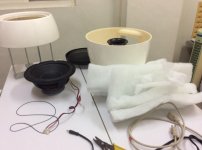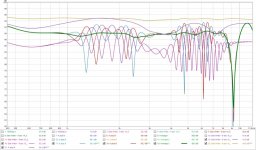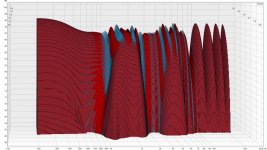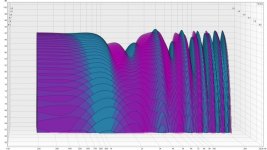I just disassembled a Scandyna sub to fix it for a friend.
Quite the flimsy construction, especially when looking at your box and.... the number of screws!
This one is only thin plastic, the dampening material is very cheap and thin, and was placed very loosely around the sides.
No wonder that thing was booming like crazy
Quite the flimsy construction, especially when looking at your box and.... the number of screws!
This one is only thin plastic, the dampening material is very cheap and thin, and was placed very loosely around the sides.
No wonder that thing was booming like crazy
Attachments
Got email from Fabfilter this morning that Pro-Q is now released as version 3 and for my case its a free upgrade, it looks Mid/Side filter have got some advanced sub settings that could interest wesayso in cross talk and image fighting also they added some advanced dynamic EQ feature, message here is not meant as a commercial for that plugin its just to inform because those two features should could make some very advanced filters possible, could really imagine those new features implemented multiple times inside MetaPlugin would give powerfull new possibilityes.
Feature links:
FabFilter Pro-Q 3 Help - Stereo options
FabFilter Pro-Q 3 Help - Dynamic EQ
Feature links:
FabFilter Pro-Q 3 Help - Stereo options
FabFilter Pro-Q 3 Help - Dynamic EQ
I just disassembled a Scandyna sub to fix it for a friend.
Quite the flimsy construction, especially when looking at your box and.... the number of screws!
This one is only thin plastic, the dampening material is very cheap and thin, and was placed very loosely around the sides.
No wonder that thing was booming like crazy
It sure looks flimsy! 8" long throw woofer? One would wonder what makes more noise with all that plastic, the driver or the enclosure...
Got email from Fabfilter this morning that Pro-Q is now released as version 3 and for my case its a free upgrade, it looks Mid/Side filter have got some advanced sub settings that could interest wesayso in cross talk and image fighting also they added some advanced dynamic EQ feature, message here is not meant as a commercial for that plugin its just to inform because those two features should could make some very advanced filters possible, could really imagine those new features implemented multiple times inside MetaPlugin would give powerfull new possibilityes.
Feature links:
FabFilter Pro-Q 3 Help - Stereo options
FabFilter Pro-Q 3 Help - Dynamic EQ
Thanks for the heads-up! I used to play with a BBE enhancer setting of my Pioneer head unit in my car which was a sort of a dynamic EQ. It worked very well to bring the kick drum to life. It targeted 2 specific frequency area's based on overall SPL levels. It was fun! Easy to overdo though.
I've heard some results of my latest experiments but have mixed feelings. While it seems to do what I wanted from it, I can't implement it without a compromise.
No form of manipulation on the phantom parts can work on the phantom centre only, as it's not a true dedicated centre. This results in the sides being also affected. I thought I could circumvent it by introducing an opposite filter to the sides, but that still introduces a side effect in the opposite channel. While I didn't quite hear it in the samples I've tested so far, it wasn´t what I envisioned when I started this idea. One can co crazy figuring all of this out.
Using the same processing on a multi channel centre has none of these drawbacks, so I can see it working very well for Home Theatre using a true dedicated centre source. That mixed phantom part does not have any side info in it if it's based on the original centre channel input to be played on a Stereo setup without a dedicated centre channel.
I'll still continue to experiment as the compromises in Stereo might still be worth it. It does do something beneficial for the phantom centre. While the original shuffler had the effect to virtually move the centre sounds back a little, this mid/side implementation does not work the same. It actually makes the central voices stand out more and be more full and clear (and feel a little closer).
Time will tell if I can actually hear any of the negatives that are introduced to the side panned sounds. Lots of variables to play with, making it even harder to make good judgement calls.
However it makes it obvious that even a separate helper centre channel will have to deal with similar problems when playing true Stereo material. I've not been able to find a way around that yet, though with having the ambient helpers it might just work convincingly enough to be worth the compromises.
If I hadn't heard what's possible with previous experiments I wouldn't even start messing around and invest the time. So far the subtle mid/side EQ I have been using has been the best step forward for me.(*) This alternative enhancement just might have enough potential, but I'm not willing to give up what I have with the wide sweet spot etc. Which means I'll probably be running lots of tests in order to find or come to my final verdict.
(*)= I've always preferred the subtle mid/side EQ above true Stereo, tested many times. Keep in mind the reduced early reflections in my room that could play a huge role in this preference. I now do get why Toole has spoken of a preference for some early reflections being present. I used to think those reflections would only be detrimental to the imaging etc. While I hold tonal balance much higher in importance than the imaging part, I now see my reduced levels of early reflections made the flaws in the Stereo concept much more obvious. I have to say I'm nit-picking here, do try it yourself to see what low level early reflections do.
No form of manipulation on the phantom parts can work on the phantom centre only, as it's not a true dedicated centre. This results in the sides being also affected. I thought I could circumvent it by introducing an opposite filter to the sides, but that still introduces a side effect in the opposite channel. While I didn't quite hear it in the samples I've tested so far, it wasn´t what I envisioned when I started this idea. One can co crazy figuring all of this out.

Using the same processing on a multi channel centre has none of these drawbacks, so I can see it working very well for Home Theatre using a true dedicated centre source. That mixed phantom part does not have any side info in it if it's based on the original centre channel input to be played on a Stereo setup without a dedicated centre channel.
I'll still continue to experiment as the compromises in Stereo might still be worth it. It does do something beneficial for the phantom centre. While the original shuffler had the effect to virtually move the centre sounds back a little, this mid/side implementation does not work the same. It actually makes the central voices stand out more and be more full and clear (and feel a little closer).
Time will tell if I can actually hear any of the negatives that are introduced to the side panned sounds. Lots of variables to play with, making it even harder to make good judgement calls.
However it makes it obvious that even a separate helper centre channel will have to deal with similar problems when playing true Stereo material. I've not been able to find a way around that yet, though with having the ambient helpers it might just work convincingly enough to be worth the compromises.
If I hadn't heard what's possible with previous experiments I wouldn't even start messing around and invest the time. So far the subtle mid/side EQ I have been using has been the best step forward for me.(*) This alternative enhancement just might have enough potential, but I'm not willing to give up what I have with the wide sweet spot etc. Which means I'll probably be running lots of tests in order to find or come to my final verdict.
(*)= I've always preferred the subtle mid/side EQ above true Stereo, tested many times. Keep in mind the reduced early reflections in my room that could play a huge role in this preference. I now do get why Toole has spoken of a preference for some early reflections being present. I used to think those reflections would only be detrimental to the imaging etc. While I hold tonal balance much higher in importance than the imaging part, I now see my reduced levels of early reflections made the flaws in the Stereo concept much more obvious. I have to say I'm nit-picking here, do try it yourself to see what low level early reflections do.
It seems that ever since the forum upgraded to https, my images don't show up anymore.
That's a problem with my certificate and it's being solved, so hang on.
So I've been working on the Home Theater part of my playback. I've done a few edits and it works with headphones, still need to test it "live" in the room.
As said, none of the drawbacks of the Stereo edits apply, so I'm expecting some good results here.
I've kept it as simple as I could, just to test. If it works out there will be plenty of opportunities to complicate it further (lol). It's good to know the headphones still give me a clear center image, the first test is to simply add an early reflection (on phantom material only). That reflection covers the 1850 to ~7 KHz area and is positive on one side, negative on the other. This way it fills in the holes created by the Stereo cross talk.
That's a problem with my certificate and it's being solved, so hang on.
So I've been working on the Home Theater part of my playback. I've done a few edits and it works with headphones, still need to test it "live" in the room.
As said, none of the drawbacks of the Stereo edits apply, so I'm expecting some good results here.
I've kept it as simple as I could, just to test. If it works out there will be plenty of opportunities to complicate it further (lol). It's good to know the headphones still give me a clear center image, the first test is to simply add an early reflection (on phantom material only). That reflection covers the 1850 to ~7 KHz area and is positive on one side, negative on the other. This way it fills in the holes created by the Stereo cross talk.
Yes it is, I did like what it did and it could just be perfect for home theater. The only problem for me, with that shuffler, was that it affected the sides as well.
There's no need for that to happen if I mix my own Stereo phantom from a multi-channel source. This way I should be able to "upgrade" my tonal balance for movies without too much drawbacks. I've always wanted to try this, just never got around to it. As the winter has set in here, giving me no opportunity to finish my subs I figured I'd revisit this concept.
I've also tried to find the differences in phase-only shuffler compared to the original and must say the original is more convincing on paper.
I did not get much listening time as I had a family member down with the flue. I expect to have a verdict on if and how this works later next week.
There's no need for that to happen if I mix my own Stereo phantom from a multi-channel source. This way I should be able to "upgrade" my tonal balance for movies without too much drawbacks. I've always wanted to try this, just never got around to it. As the winter has set in here, giving me no opportunity to finish my subs I figured I'd revisit this concept.
I've also tried to find the differences in phase-only shuffler compared to the original and must say the original is more convincing on paper.
I did not get much listening time as I had a family member down with the flue. I expect to have a verdict on if and how this works later next week.
Hmmm.... I had to think about that for a moment. But of course you have no center speaker! So you still need to take into account the 2 speaker head shadowing because even your dedicated center channel is still playing phantom.There's no need for that to happen if I mix my own Stereo phantom from a multi-channel source. This way I should be able to "upgrade" my tonal balance for movies without too much drawbacks..
At least a 5.1 gives you a dedicated center channel to work on independently, unlike stereo. Going to be interesting to see what you come up with and what works best.
Exactly, the phantom problem exists for me with 5.1 sources too, except this time we do get a dedicated center channel to work with.
I've got to "fake" the tonal balance of the center channel as if it's coming from a front source.
It's a little easier to do than files originating from a real stereo source as it does not disrupt any side panned sounds (yellow line in the upper graph).
The phantom center balance at the ears looks like this:
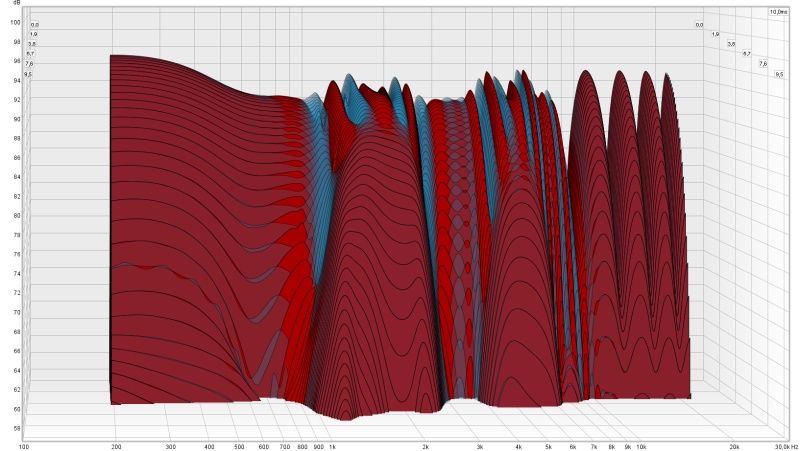
(green average in the above post)
As opposed to the usual cross-talk dips which present themselves at both ears:

I've got to "fake" the tonal balance of the center channel as if it's coming from a front source.
It's a little easier to do than files originating from a real stereo source as it does not disrupt any side panned sounds (yellow line in the upper graph).
The phantom center balance at the ears looks like this:
(green average in the above post)
As opposed to the usual cross-talk dips which present themselves at both ears:
Attachments
This is what this "swopper" is all about, strange huh?
Per filter it looks like distortion but with multiple filter sums and acoustic paths plus a brain its probably a bit different
Basically, I wanted to solve this for Stereo, however in Home Theater I do have the same problem. Having the discrete center channel to work with is a plus.
If I can get this to sound decent, I bet I can improve general stereo as well.
Yes BYRTT, it looks like a big mess, but think of it, any signal from a speaker out in a room that hits your ears wil look quite similar if you have some kind of early diffraction or reflection upsetting the balance. You can't see it if the measurement is smoothed, but just look past a known room reflection in a waterfall plot.
The plot I show here is taken at 3.5 ms after the main pulse:

Within my room, the first larger reflections happen after 6.5 ms, before that it still is a clean clear ridge. I've basically added virtual reflections to the phantom signal to disrupt it and fill in the dips. Mid/Side EQ is still used to balance things out even further.
The biggest difference with this compared to the original shuffler (not the later phase shuffler that followed) is timing. This is what that one looks like when we compare them in a similar way:
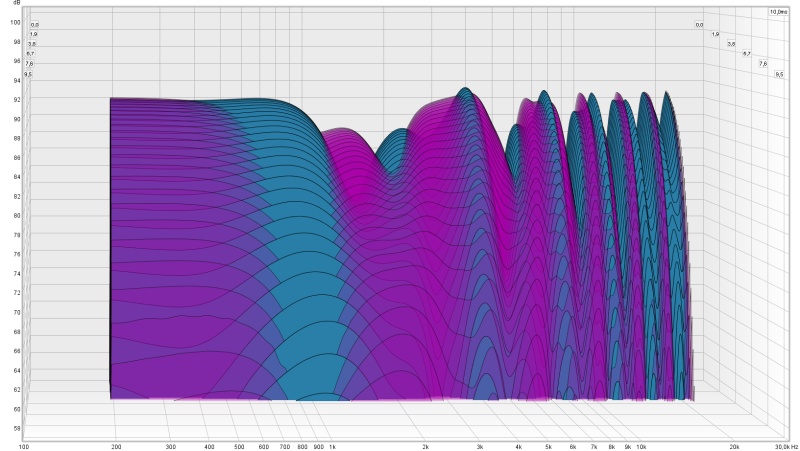
The later we time the "correction", the closer the dips and peaks become. Honestly, I do have no idea what the ideal timing would be yet.
But when we fill in those dips for phantom center material, it starts to sound more right, tonally. The reason for me to time it later than the previous shuffler from Pano is
that left and right balance becomes more equal in the proces. We don't seem to be al that sensitive to a closely timed comb pattern.
If I can get this to sound decent, I bet I can improve general stereo as well.
Yes BYRTT, it looks like a big mess, but think of it, any signal from a speaker out in a room that hits your ears wil look quite similar if you have some kind of early diffraction or reflection upsetting the balance. You can't see it if the measurement is smoothed, but just look past a known room reflection in a waterfall plot.
The plot I show here is taken at 3.5 ms after the main pulse:
Within my room, the first larger reflections happen after 6.5 ms, before that it still is a clean clear ridge. I've basically added virtual reflections to the phantom signal to disrupt it and fill in the dips. Mid/Side EQ is still used to balance things out even further.
The biggest difference with this compared to the original shuffler (not the later phase shuffler that followed) is timing. This is what that one looks like when we compare them in a similar way:
The later we time the "correction", the closer the dips and peaks become. Honestly, I do have no idea what the ideal timing would be yet.
But when we fill in those dips for phantom center material, it starts to sound more right, tonally. The reason for me to time it later than the previous shuffler from Pano is
that left and right balance becomes more equal in the proces. We don't seem to be al that sensitive to a closely timed comb pattern.
Attachments
Last edited:
...The phantom center balance at the ears looks like this:
...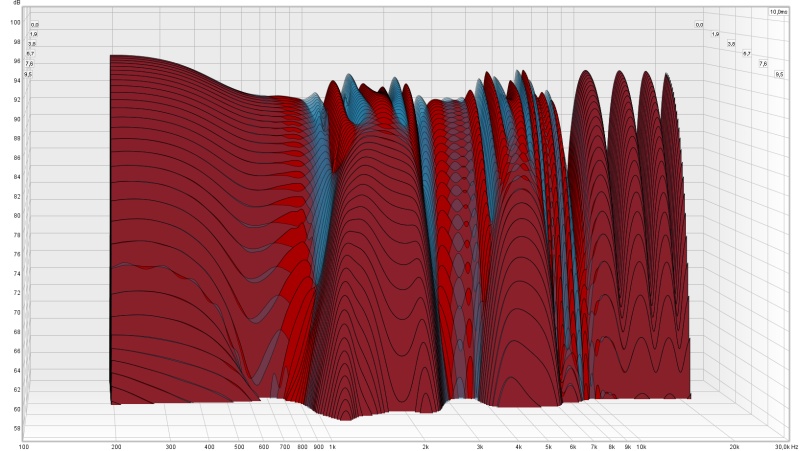
Attachments
All I had so far were 2 brief listening sessions. However this made clear that it isn't just a simple tweak to get back proper tonal balance. Basically, I'm starting from scratch.
On the other hand, it does sound promising.
Working with a pure center source and learning how to mix it in should give me some pointers on how to set it up for Stereo. It is obvious there are some important differences between the two. I'll need way more time though, and need to find some way of measuring to make life easier. I'm guessing a head size foam ball and a microphone should help.
On the other hand, it does sound promising.
Working with a pure center source and learning how to mix it in should give me some pointers on how to set it up for Stereo. It is obvious there are some important differences between the two. I'll need way more time though, and need to find some way of measuring to make life easier. I'm guessing a head size foam ball and a microphone should help.
There are some "junior size" footballs that are about head sized. Normal footballs are too wide to imitate ear spacing. A rugby ball might work.
You mean like this?

I'm guessing a head size foam ball and a microphone should help.
Styrofoam wig head stands can be had for under $5 USD from Amazon.
Good idea Craigsu.
This is pretty good and easy to fit mic’s in.
Amazon.com : A1 Pacific Female Styrofoam Mannequin Head, 11" L : Beauty
This is pretty good and easy to fit mic’s in.
Amazon.com : A1 Pacific Female Styrofoam Mannequin Head, 11" L : Beauty
- Home
- Loudspeakers
- Full Range
- The making of: The Two Towers (a 25 driver Full Range line array)
